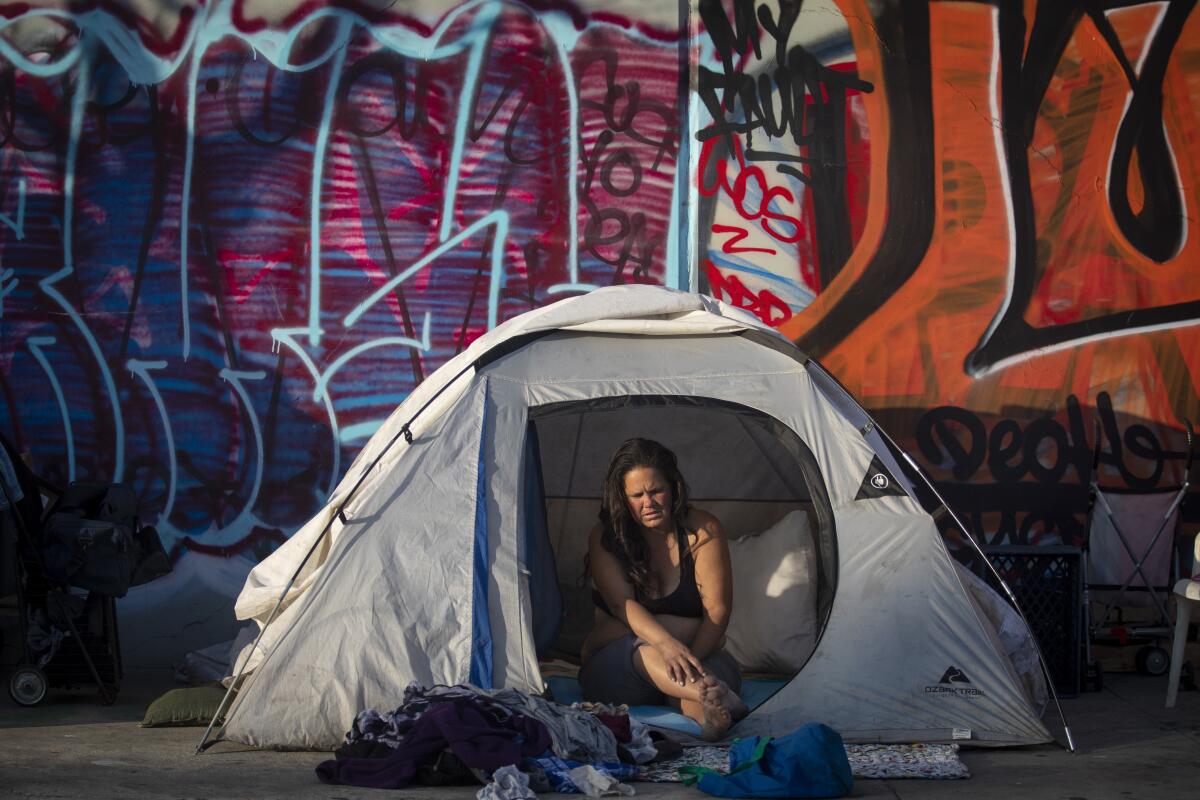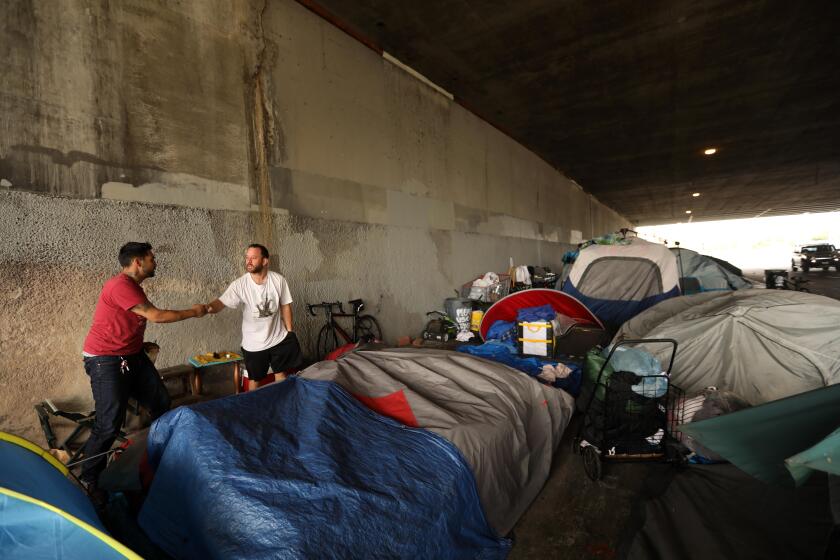Column: So Trump wants to solve homelessness in California? Here are five things he can do

They want to help.
That’s what we keep hearing from President Trump’s minions about California’s massive homelessness crisis.
Trump’s homeless czar, Robert Marbut, was in town last week, and I got a chance to sit down with him. U.S. Housing and Urban Development Secretary Ben Carson was also in Los Angeles last week, though not talking to me. He was reportedly working on a deal — the details of which remain a mystery — with local officials.
Although they both talked a lot while they were here, it was hard to get a clear sense of what, if anything, Trump and his team intend to do.
So call me a skeptic.
It’s not as if there’s no room for criticism of local efforts, and I’ve leveled some myself.
But this is an election year, and Trump is guaranteed to pound away at his theme that Democrats are clueless, horrible, evil people, and California is Exhibit A of the horrors visited on places that elect them.
But for the sake of argument, let’s say the president really does want to help. I’m here to facilitate, and in that spirit, I have five recommendations.
1. Quit playing games
It’s hard for us to take any of this seriously when, after months of so-called negotiations with local officials, Carson on Friday announced the formation of a joint working group.
Holy Jehoshaphat, what a breakthrough!
Carson and L.A. Mayor Eric Garcetti have both alluded to federal land that might or not be made available for housing or some such, and there have been references to more federal resources and fewer regulatory barriers to progress, as yet unspecified.
“We’re examining pieces of property,” said Garcetti, who hasn’t been much more forthcoming than the Trumpies. “We can’t discuss it yet, but we’re talking about which resources we would both bring to the table to help build things.”
Well, let’s move it along.
2. Quit playing games, part 2
Although Carson had little to say about how the city, county and federal governments might better work together to address homelessness, he did offer up an idea to my colleagues at The Times that according to him would solve everything.
Namely, he plans to roll out a plan that will ask religious institutions across the United States to adopt homeless people.
“Can you imagine what the impact of that will be?” Carson asked. “Pretty much wipe out homelessness.”
You think so?
This is essentially a rehash of what former President George H.W. Bush suggested in his 1988 call for more volunteerism. He referred to it as a “thousand points of light.”
I do agree that faith organizations can and should so more. For one thing, we need more churches and synagogues to join the Safe Parking movement and make their parking lots available overnight to people living in their vehicles.
But as Carson dusts off the idea to have faith organizations take over the government’s role of human services, does anyone recall what Trump said about Bush’s initiative a few months before Bush’s death?
Here you go:
“’Thousand points of light.’ I never understood that one. What the hell is that? Has anyone ever figured that one out?”
3. Housing, housing, housing
The same week Carson and company visited California to solve homelessness, does anyone know what Trump was up to?
He was releasing his 2020 budget proposal, which called for an $8.6-billion cut for the housing department headed by Carson. This would include the slashing of affordable housing grants to help states and cities build or purchase rental units. By one estimate, more than 150,000 families could lose their homes.
“I’m a little cynical,” California Assemblyman Miguel Santiago (D-Los Angeles) told me. “If they want to help California, they’re doing the complete opposite of that with budget decreases in areas that will depress and deepen the divide in income inequality.”
Carson told The Times that Trump’s proposed cuts were intended as negotiating points, and he predicted that no one would lose their home.
That said, some of his ideas were difficult to follow. Carson said at one point during his visit that we need to reconsider zoning that allows only single-family homes in some neighborhoods. At another point, as my colleague Benjamin Oreskes reported, Carson “questioned the value of putting apartments in single-family neighborhoods.”
Let me make this clear, since he didn’t:
Local zoning isn’t a federal matter. But we do need a stable source of federal funding for affordable housing, we’re doomed if the Trump plan is for more cuts, and we need whatever federal land can be freed up.
So get to work.
Help us inform our reporting about the homelessness crisis in California by submitting your questions.
4. Spare us the colored charts
Marbut, the Trump homeless czar, was roundly criticized as too much of a hard-liner when he was hired late last year, with some homeless advocates saying he seemed inclined to blame homeless people for their predicament. As a consultant to various cities, he has recommended banning people from sleeping on the street, as well as outlawing panhandling and charitable food distribution.
When Marbut met with me and my colleagues, he offered up a chart suggesting that beginning in 2014, homelessness surged nationally because of a greater emphasis on housing than on services. But his interpretation failed to take into consideration the exploding opioid and drug epidemic or growing income inequality, which drove the higher numbers. And in L.A. County, our services have increased dramatically in recent years.
One of Marbut’s main points was that simply housing people doesn’t work long term unless they get proper services, and that taking advantage of those services has to be part of the deal.
I agree that some people need the kind of structure Marbut is talking about. But for many others, especially those with mental illness and/or addiction, it gets complicated. Forcing people to accept services as a condition of housing could drive the homeless numbers up, not down.
Marbut also argued that we could build more and reduce the cost of new affordable housing by one-third if local officials rolled back regulatory red tape and building fees. That process has already begun, to a degree. But still, how do you finance the massive amount of housing that’s needed when Trump is slashing HUD’s budget?
Here’s a practice-what-you-preach thought for Team Trump:
Waive federal regulatory restrictions at the West L.A. Veteran Affairs campus, open that vast acreage to new affordable housing, and get to work.
As Marbut said to me and my colleagues, it’s time to ask:
“What can you do today, tomorrow and in the next week, not three years from now?”
5. Get moving on that campaign promise of better, cheaper healthcare for all
Millions have lost health insurance since Trump took office, and that doesn’t help the homeless problem.
You can become homeless because you got sick and couldn’t pay the bills.
You can get sick because you become homeless.
About 1,000 homeless people are dying each year in L.A. County, many with long-term untreated disease. They die about 30 years younger than the greater population.
Severe, untreated mental illness is common in homeless populations. So is untreated addiction.
Trump’s proposed budget would cut $85 billion out of Medicare, slash Medicaid by $920 billion, Social Security by $30 billion and food stamp spending by $181 billion over the next decade.
That will decrease homelessness how?
So there you have it. Five simple ideas for an administration that says it wants to help.
Call me if I can be of further assistance.
More to Read
Start your day right
Sign up for Essential California for news, features and recommendations from the L.A. Times and beyond in your inbox six days a week.
You may occasionally receive promotional content from the Los Angeles Times.








